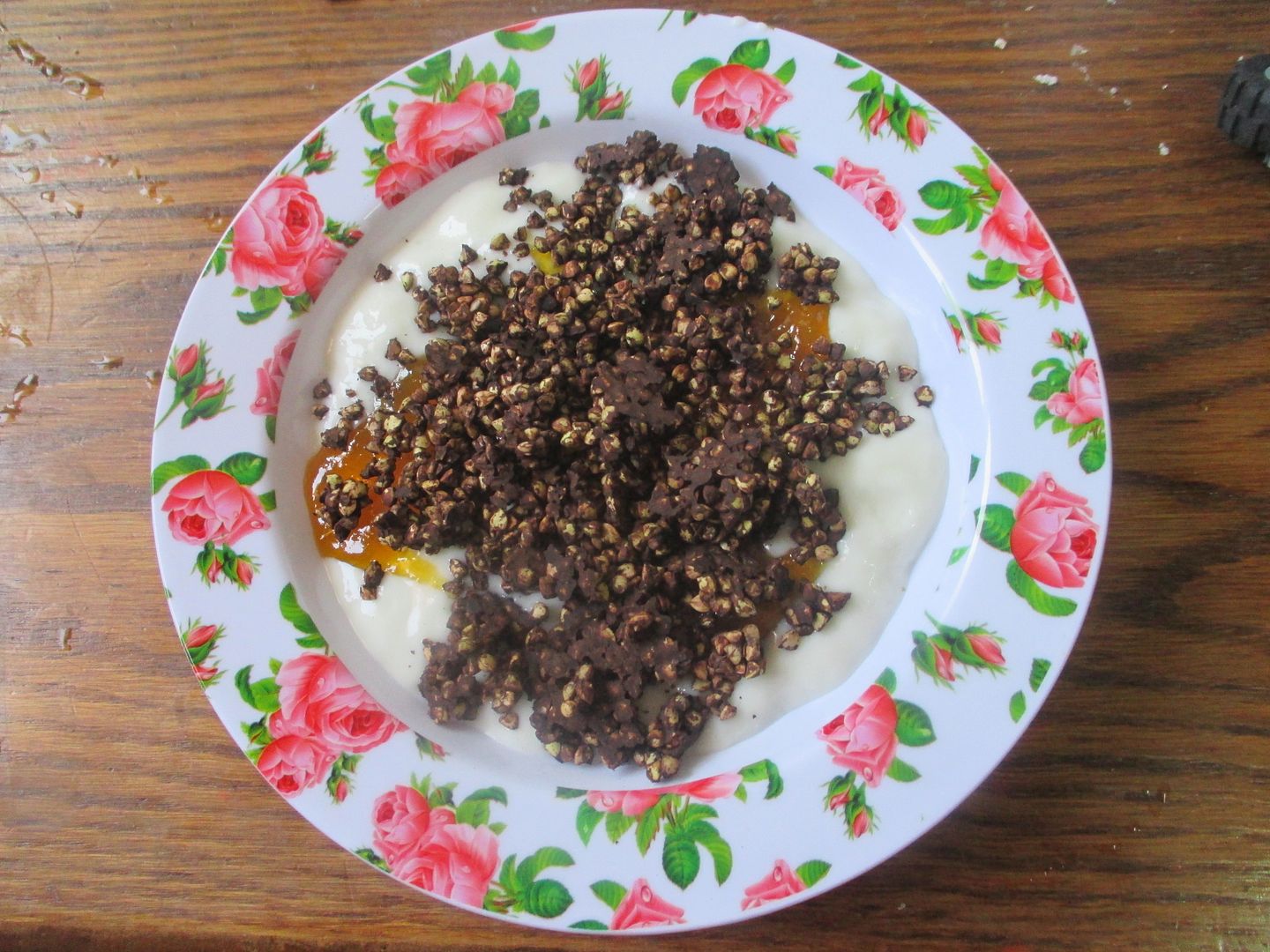 |
| Sunflower milk yogurt with raw chocolate buckwheat granola and apricot jam |
If you haven’t noticed from yesterday’s post… I’m on a bit of a dairy kick. After 2 or more years of not making homemade yogurt, I just made 2 batches 2 days ago. One batch of dairy yogurt, for my kids… and one batch of sunflower milk yogurt for myself, since I don’t want to push my recently acquired ability to eat minimal dairy too far.
A few years ago I shared my instructions for how I make my homemade dairy yogurt, and I figured I’d repost it, as well as post instructions for making dairy free yogurt.
In short, to understand why you make yogurt the way you do, understand that yogurt is a fermented food made by inoculating warm milk with probiotic beneficial bacterias, usually acidophilus and bifidus and a few others, which then eat the sugars in the milk, leaving behind lactic acid, curdling the milk, turning the liquid milk into a thicker yogurt.
When making dairy free yogurts, even though you inoculate it with the same bacteria, because sunflower milk, almond milk, soy milk, etc… don’t have the same property as dairy milk, they don’t thicken on their own. So dairy free yogurts need to first be thickened, like pudding, and after they are thickened, they are inoculated with the starter culture, which then eat the sugars and turn the thickened milk into a sour yogurt.
Some people are weirded out by the fact that you leave this milk in a warm place for a while- they’re afraid of spoilage. What it’s important to be aware of is that if the milk is inoculated with the good bacteria, and then put at a warm temperature, the beneficial bacteria will replicate to such an extent that spoilage causing bacteria will be prevented from growing, and your milk will not only not spoil from being kept warm for a few hours, but it will also end up lasting longer, even after, when refrigerated, than if it had not been made into yogurt. If the milk isn’t kept warm, the beneficial bacteria will not replicate, and you will not get yogurt.
I am not super sensitive to dairy anymore, so I inoculate my sunflower milk yogurt with a little bit of dairy yogurt with live cultures in it. I have looked for dairy free yogurts with live cultures in them, but I haven’t seen any sold locally or I’d use a bit of that to inoculate it. If you want yours to be completely dairy free, look for a non dairy yogurt with live cultures to do this, or you can also use powdered yogurt culture (which you can buy online) and some people even say you can use powdered probiotics from inside capsules, but I never tried that so I have no personal experience with it to tell you how it would turn out.
I make my yogurt without a special yogurt maker- the only special equipment needed is a cooler or other insulated container, as well as a hot water bottle.
Homemade Yogurt Recipe- Dairy Yogurts, and Non Dairy Sunflower Milk Yogurt, Almond Milk Yogurt, Etc…
Ingredients for Dairy Free Yogurt
1/8 tsp salt (optional)
6 cups sunflower milk or other non dairy milk such as almond milk, soy milk, hemp milk, etc…
2/3 cup potato starch, corn starch, or tapioca starch
2 tablespoons yogurt with live cultures in it, or powdered yogurt culture
Ingredients for Dairy Yogurt
8 cups milk (cow’s milk or goat’s milk)
2 tablespoons yogurt with live cultures, or powdered yogurt culture
Instructions
1. For dairy free yogurt: If using homemade non dairy milks, consider adding 1/8 of a teaspoon salt (if you didn’t already add any to the batch when you made it). You can skip this if you want. If using store bought non dairy milk, don’t use this.
2. For dairy free yogurt, add the starch to the milk and mix well so there are no clumps. Heat up the milk, stirring constantly, until it thickens to the thickness of pudding. If making dairy yogurt, heat up the milk until it is nearly boiling.
3. Let the milk or pudding cool down until it is a tiny drop higher than body temperature- you want it about 100 degrees Fahrenheit, or 37.5 Celsius. You don’t need a thermometer for this- just touch it with your finger- you want it hot to the touch, but not too hot that it burns you- you want it to be the temperature of a hot bath.
4. Mix in the yogurt with either your milk or your pudding.
5. Move into the container in which you want to store your yogurt. I generally use a plastic covered “Tupperware” style container, others use glass jars.
6. Place the inoculated milk/pudding into a cooler. Add a hot water bottle or 2 and close.
7. Leave undisturbed for 7-10 hours. You may open it up after 4-5 hours or so and replace the hot water in the hot water bottle to make sure the temperature in the cooler stays hot, even after many hours.
8. Open the cooler. If making dairy yogurt, it should be fully thick by now, possibly with a little whey separated and on the top. If dairy free yogurt, it’ll be a little thinner than when you put it in, and it’ll also have some whey on the top probably. In either case, it should smell and taste somewhat tart but not very.
9. Remove from cooler and place in the refrigerator. Place there minimum for a few hours, until cooled. It will thicken a bit more, and is now ready to eat.
10. If desired, sweeten. Otherwise, you’ll have plain yogurt. Do NOT add flavorings or sugar before inoculating, only after it is already made.
I took some pictures of the finished products, in their containers. (After we already ate some.) Sorry, not so photogenic or easy to see the texture from these pics…
 |
| Sunflower milk yogurt with raw chocolate buckwheat granola and apricot jam |

.JPG)





